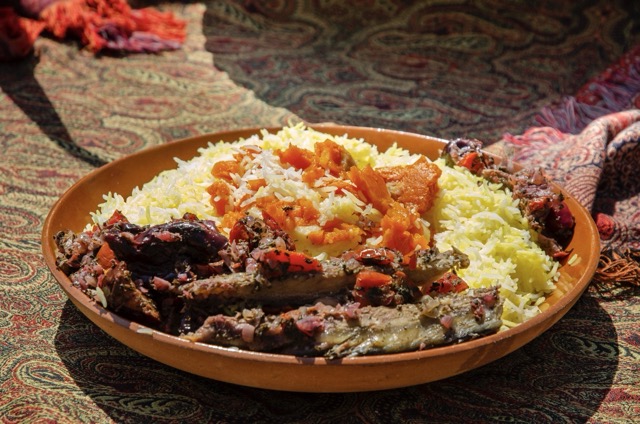Affiliate Disclaimer: As an Amazon Associate I earn from qualifying purchases.
Persian cuisine is known for its rich stews, aromatic rice, and flavor profiles that balance sweet, sour, and savory in ways that are both complex and comforting. Among the many iconic dishes in the Iranian culinary tradition, Khoresh-e Fesenjan (also spelled fesenjoon) stands out as one of the most beloved. Made with ground walnuts and pomegranate molasses, this stew is earthy, slightly sweet, and deeply satisfying. Traditionally simmered for hours, fesenjan is often reserved for family gatherings or festive occasions.
For those who love the dish but do not have the time to make it from scratch, Sadaf Khoresh Fesenjan – Walnut & Pomegranate Stew offers a convenient, ready-to-eat option. The big question is whether this jarred version can capture the essence of the original. In this review, we look at its flavor, texture, ingredients, and how it fits into a modern Persian or fusion kitchen.
What Is Fesenjan?
To appreciate what Sadaf is offering, it helps to understand what fesenjan is. This traditional Iranian stew originates from the northern regions of Iran, particularly Gilan and Mazandaran. It is typically made by simmering ground walnuts with pomegranate paste or molasses, often paired with duck, chicken, or meatballs. The slow cooking allows the flavors to deepen and the texture to thicken naturally into a rich, luxurious sauce.
Preparing fesenjan the traditional way can take several hours. It requires carefully grinding walnuts, adjusting the balance between tart and sweet, and watching the stew to ensure it thickens without burning. It is rewarding, but not exactly quick.
That is where a product like Sadaf’s comes in.
What’s Inside the Jar?
Sadaf Khoresh Fesenjan comes in a 12-ounce glass jar and is labeled as vegetarian. The ingredients include walnut, fried onion, tomato paste, pomegranate paste, mashed potatoes, sugar, vegetable oil, salt, and spices.
The inclusion of mashed potatoes is unconventional but may be used to add body and smoothness. Sugar, also included, is present in many homemade versions of fesenjan. However, sweetness levels vary based on family tradition and regional preferences, so some users may find it slightly sweeter than expected.
Flavor and Aroma
Once opened and heated, the stew releases a warm, nutty aroma that will be familiar to anyone who has had homemade fesenjan. The pomegranate flavor is prominent, delivering the tartness the dish is known for. The sweetness level is noticeable but not overwhelming, especially when served with plain rice.
The walnut flavor is well-developed, providing a rich base that tastes both hearty and refined. The stew is entirely smooth, which may please those who prefer a uniform consistency. Traditional fesenjan sometimes contains small bits of walnut or visible pomegranate seeds, so purists may notice the difference in texture. However, for a jarred product, the flavor is remarkably close to homemade.
How It Feels on the Palate
The texture is thick, smooth, and rich, with just the right amount of viscosity to coat a spoon or rice without feeling heavy. The walnuts have been processed finely, resulting in a creamy consistency. There is no visible separation of oil, which is common in many authentic homemade versions where the natural oil from walnuts rises to the top.
If you are serving this with basmati or Persian-style steamed rice, it absorbs well and retains flavor with every bite. You can also pair it with flatbread or roasted vegetables if you are looking for a lighter or more casual presentation.
Serving Suggestions and Versatility
Here are several ways to enjoy Sadaf Khoresh Fesenjan:
- Serve it over saffron rice for a traditional meal.
- Add cooked chicken, meatballs, or even tofu to create a protein-rich entrée.
- Use small amounts as a filling in wraps or savory hand pies.
- Pair it with roasted root vegetables or lentils for a vegan-friendly plate.
Garnishing with fresh pomegranate seeds or parsley will enhance both flavor and visual appeal, especially if you are serving guests.
Strengths and Limitations
Strengths:
- Captures the essential flavors of fesenjan with minimal preparation.
- Shelf-stable and ready in minutes.
- Vegetarian-friendly.
- Smooth and creamy texture.
- Easy to customize with added ingredients.
Limitations:
- Slightly on the sweeter side for those who prefer more tartness.
- Contains mashed potatoes, which some may find untraditional.
- No protein included.
- Flavor depth may not match slow-cooked homemade versions exactly.
Summary
Sadaf Khoresh Fesenjan – Walnut & Pomegranate Stew is a highly convenient option for anyone craving authentic Persian flavors without the labor involved in traditional preparation. While it may not fully replicate the experience of a home-cooked version that simmers for hours, it comes very close and serves as an excellent base or standalone meal.
For Persian food lovers on the go, busy families, or curious home cooks who want to try something new, this product delivers. With a little creativity and a few additions, it can be transformed into a centerpiece dish that feels both comforting and elegant.
Where to Buy
You can purchase this ready-to-eat fesenjan online:
👉 Buy Sadaf Khoresh Fesenjan on Amazon
Affiliate Disclaimer: As an Amazon Associate I earn from qualifying purchases.
The Deeper Meaning of Fesenjan in Persian Homes and Celebrations
Fesenjan is not just a stew. It is a cultural treasure that holds emotional significance in many Persian households. For generations, this dish has been more than just food. It has served as a symbol of care, tradition, and family unity. Whether served at Yalda Night, Nowruz celebrations, weddings, or formal family dinners, fesenjan carries a sense of occasion and meaning that is hard to replicate with other dishes.
In a traditional Iranian kitchen, preparing fesenjan is viewed as an act of devotion. The process is not quick or simple. It begins with soaking and grinding walnuts, then continues with slowly simmering the sauce to bring out its natural oils and flavors. The balance between tart pomegranate paste and the natural richness of the nuts must be carefully maintained. It is not a dish that rewards shortcuts, which is why it is often considered a culinary milestone among Persian cooks. Many Iranians learn to make fesenjan not from written recipes, but by watching parents and grandparents do it by feel, with instinct and inherited knowledge.
Visually, fesenjan also stands apart. Its deep brown, almost black color may appear unusual to newcomers, but to those raised with Persian food, it signals complexity and depth. The dark hue is a mark of a well-cooked walnut sauce that has been given the time it needs to mature. When served with bright saffron rice, crispy tahdig, or sprinkled with fresh pomegranate seeds, the contrast on the plate is striking.
The emotional pull of fesenjan is perhaps its most powerful feature. For Iranians living abroad, the scent of simmering walnuts and pomegranate can bring back vivid memories of childhood meals, grandparents’ kitchens, and the comfort of home. In many families, this stew is one of the first things people request when returning from a trip or feeling homesick. It is a dish that carries memory and emotion along with flavor.
That is what makes the convenience of a ready-made version so important. A jar of Sadaf Khoresh Fesenjan is more than just a product on a shelf. It is a connection point for those who no longer have the time, energy, or access to make fesenjan the traditional way. For members of the Iranian diaspora, it can be a gateway back to their cultural roots. For those new to Persian food, it offers an authentic starting point without the intimidation of complex preparation.
Using a pre-made fesenjan does not mean sacrificing tradition. It means adapting tradition to modern life. The flavor may be slightly different from homemade, but the essence remains intact. This stew continues to serve its original purpose: to nourish, to comfort, and to connect people across time, geography, and generations.
Whether you are preparing a quick dinner after work or serving guests who have never experienced Persian cuisine, this dish has the ability to make an impression. It speaks quietly but deeply. It reminds us that food is not just about sustenance. It is about belonging, history, and identity.
Beyond Tradition: Creative Ways to Use Sadaf Khoresh Fesenjan in Modern Cooking
While Sadaf Khoresh Fesenjan is deeply rooted in one of Persia’s most beloved culinary traditions, it also offers a surprising amount of versatility. With its rich walnut base and sweet-tart pomegranate flavor, this stew can be used in more than just traditional presentations. Home cooks looking to expand their horizons will find that this product serves as both a flavorful sauce and a creative base for fusion dishes that bridge Persian flavors with global ingredients.
One practical and flavorful application is to use the stew as a glaze or finishing sauce for roasted meats and vegetables. The walnut oil and pomegranate paste work well with oven-roasted chicken, lamb, or even squash. Simply warm the fesenjan, brush it over the food during the final ten minutes of roasting, and let the natural sugars caramelize for a rich and slightly sticky finish. This method works particularly well with bone-in chicken thighs or thick slices of roasted eggplant.
For wraps, sandwiches, or handheld meals, the stew can be blended with shredded chicken, lentils, or mashed chickpeas and used as a savory filling. Tuck the mixture into lavash or pita bread and add sliced cucumbers, red onions, and fresh herbs. A spoonful of yogurt on top adds brightness and contrast. This version is especially popular among those who want the essence of fesenjan without preparing a full rice-based meal.
Another creative idea is to use Sadaf Khoresh Fesenjan as a stuffing component or baked filling. Combine it with cooked rice, chopped walnuts, and herbs to fill bell peppers or mushrooms, then bake until tender. The mixture holds its shape well and offers a bold, unexpected flavor that balances richness with a subtle tang.
Vegetarian meals also benefit from the stew’s adaptability. Try mixing it into warm grain bowls with quinoa, roasted carrots, sautéed greens, and chickpeas. The stew adds moisture and complexity to otherwise simple ingredients. Adding a splash of lemon juice or sumac can elevate the flavors further, especially if you’re working with roasted or earthy vegetables.
For an East-meets-West dinner, the stew can be used as a pasta sauce. Thin it slightly with olive oil and pasta water, then toss it with tagliatelle or rigatoni. Crumbled feta or shaved parmesan adds a salty contrast to the sauce’s sweet notes. This combination surprises many first-time tasters, but the nutty base and pomegranate undertones create a flavor profile not unlike Roman or Georgian walnut sauces.
Even for small bites or appetizers, Sadaf’s stew finds a home. Serve it warm in a small dish alongside flatbreads and fresh herbs, much like a Persian tapenade. You can top it with pomegranate seeds or chopped pistachios for added texture and visual appeal. This is an easy way to introduce Persian flavors at parties or gatherings without needing a full entrée.
These alternative uses do not replace traditional fesenjan, but they open up new ways to enjoy its flavor with everyday ingredients. Whether you are creating a weekday dinner, hosting guests, or experimenting with cross-cultural cooking, this stew adds richness and balance that works across many culinary styles.
One jar of Sadaf Khoresh Fesenjan becomes more than just a convenient pantry item. It becomes a base for creativity, an introduction to Persian flavor traditions, and a flexible element in both classic and modern meals.










